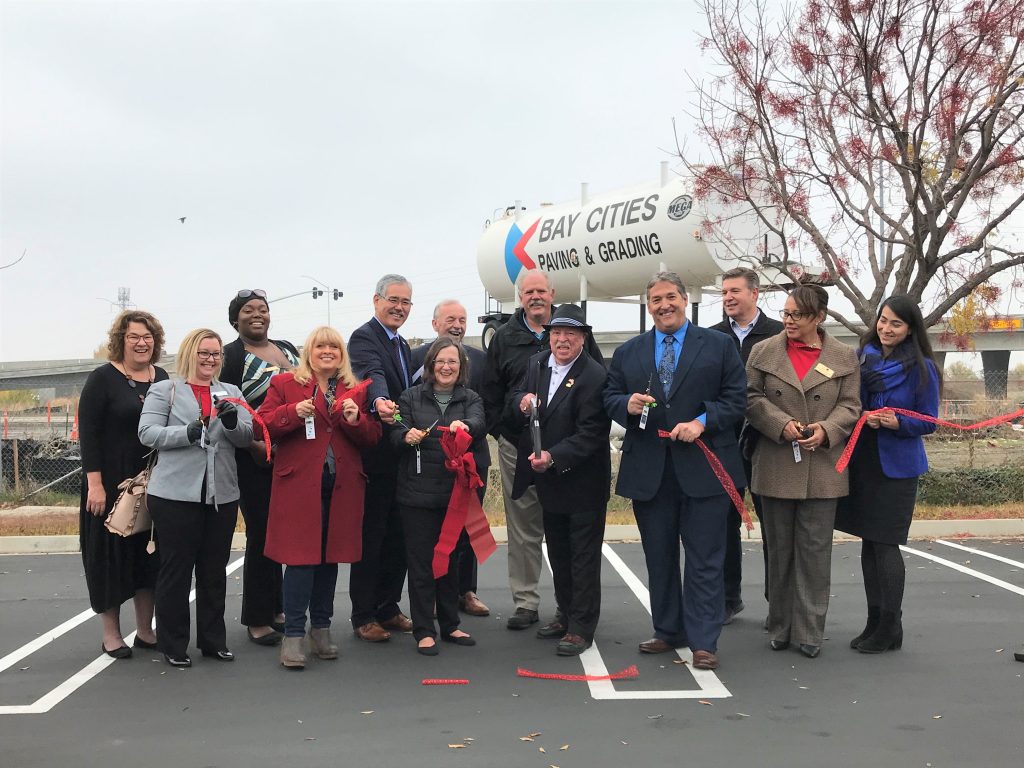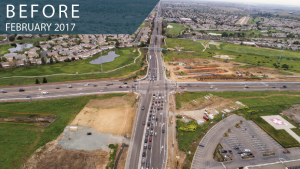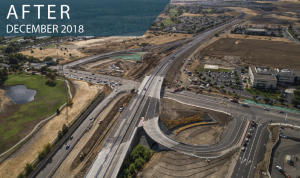
Elected officials and staff from Brentwood, East County and the Contra Costa Transportation Authority cut the ribbon to mark the opening of the new Balfour Road – Highway 4 Interchange on Monday, Dec. 10, 2018. Photo by Allen Payton
20 years since the right-of-way was purchased, completes $1.3 billion in East County transportation projects
The Contra Costa Transportation Authority (CCTA) and its partners, the Contra Costa Water District (CCWD), the Contra Costa Regional Fee and Financing Authority (ECCRFFA), the California Department of Transportation, and the City of Brentwood, held a ribbon cutting ceremony for the completion of the Highway 4 and Balfour Road Interchange Project. CCTA was joined by State, regional, and local officials to celebrate the completion of the interchange project, which brings much-needed traffic relief to Brentwood and Contra Costa County.
“Today’s ribbon cutting is one more symbol of the transformation taking place in Brentwood and Eastern Contra Costa County,” said CCTA Vice Chair and Brentwood Mayor Bob Taylor. “This project has reduced traffic, improved safety, and will have long term economic benefits for our region.”
He stated that the project was “on time and under budget.”
“This organization does a wonderful job. This is an amazing structure and it will be here for generations,” Taylor added.
The Balfour Road Interchange Project replaced the existing signalized, at-grade intersection at Balfour Road and State Route 4 with a grade-separated interchange and corresponding on- and off-ramps. The project involved raising State Route 4 to cross over Balfour Road, creating a new, safer undercrossing. This new configuration has eased traffic congestion and improved safety at this intersection for motorists, cyclists, and pedestrians
The project was one of the first in the state to use innovative drone technology to monitor construction progress. With assistance from engineering firm Alta Vista Solutions, CCTA flew drones equipped with a combination of LiDAR and camera technology to measure the volumes of earth that were moved during the $42 million construction project. Utilizing this technology enabled CCTA to track construction progress firsthand and improve safety by taking workers out of live traffic.
“In 2008 when I was rescued from CalTrans, we finished the work on the Loveridge interchange,” stated CCTA Executive Director Randy Iwasaki. “Here we are and now we’re opening the last segment of the projects we had identified. Today marks the official opening of the $42 million Highway 4, Balfour Road interchange.”
“We are always looking for new ways to increase safety and efficiency on construction projects,” he shared. “Drones give us aerial views of the site that were hard to come by before, making it safer for surveyors to do their job and helping us manage the large volume of dirt that was used to improve this intersection. This technology also allowed us to monitor environmentally sensitive areas without disturbing the habitat.”
Innovation on the project extended beyond the use of technology. CCTA also facilitated a collaborative, multi-agency agreement that saved both time and money for the Balfour Road Interchange project. Prior to the start of construction, CCTA and the Contra Costa Water District (CCWD) worked together to gain Caltrans approval to leave the 90-inch Los Vaqueros Pipeline in place along the project alignment, essentially building the new highway infrastructure in conformity with the existing pipeline. Rather than a complete relocation of the relatively new pipeline, CCTA, CCWD and Caltrans arrived at a design that maintained the reliability and longevity of the infrastructure, worked for all agencies, reduced environmental and community impacts – which saved Contra Costans approximately $18 million in environmental permitting, property acquisition and construction costs.
Constance Holdaway, Vice President of the CCWD Board of Directors said, “We have a 90-inch pipeline running through this area from the Los Vaqueros Reservoir.” She gave credit to “creative minds” which “ssaved money and minimized environmental impacts.”
State Assemblyman Jim Frazier, who served on the CCTA Board in the past, and is now Chairman of the Assembly Transportation Committee shared some background on the funding for the project.
“We delivered $83 million for Highway 4 improvements including this project,” he stated. “We went hat in hand” to the state capital asking for funding.
“You were very sick, that day,” Taylor interjected.
“Yes, I was. I checked myself out of the hospital to go that day. Then I checked myself back in,” Frazier shared.
“I have to recognize the good work of the CCTA, and the contractors Brosamer & Wall and Bay Cities,” he continued. “I want to thank the CC building and trades and the CHP working to protect the workers.
“Randy and I are working on the Sand Creek (Road) project from the interchange to Kaiser, with the developers,” Frazier stated. “I’m also working with Tri Delta Transit and instead of BART, we’re looking at a bus rapid transit system from Hillcrest to Marsh Creek Road.”
Supervisor Diane Burgis, Chair of the Eastern Contra Costa Regional Fee and Financing Authority, which collects and provided developer fees for the project, said “Today, we have a project that really contributes to the quality of life in Eastern Contra Costa County. Residents who use this road…they’re going to get home quicker.”
She acknowledged Dale Dennis who was the lead staff member for the Bypass Authority.
“Those of us who are using this freeway are already enjoying the benefits of it,” Burgis added
Former State Route 4 Bypass Authority Chairman, Allen Payton, offered some history about the project, honoring Tom Torlakson, who was a County Supervisor at the time he proposed the idea of the extension to Highway 4, formerly known as the “bypass”. Payton stated it was 20 years ago, this year that the authority approved the purchase of 250 feet of right-of-way for the segment between Lone Tree Way and Balfour Road for $950,000 to provide room for four lanes of traffic and two lines of transit.
“It started out in 1994 with three votes in favor versus eight votes against at the CCTA,” he shared. “It took us four years to get to an 11-0 vote to approve the road.”
He thanked Iwasaki and Frazier for “finding the hidden pockets of state money” to complete the freeway extension. Payton also encouraged the elected representatives in attendance, specifically Frazier, of the need to speed up the approval and implementation process for traffic improvements. Iwaski agreed.
Iwasaki then mentioned the funding from the county’s half-cent sales tax Measure J and thanked CCTA staff members Jack Hall, Stephanie Hu, Linsay Willis, Susan Miller, Tim Hale and Ross Chittenden for their work on the project. He also acknowledged “the engineering and design, and construction teams and all the subcontractors, the men and women who built this project.” They included Quincy Engineering, specifically Carl Gibson, the chief designer on the project and PSOMAS, specifically Bonaventure Ezeji, the resident engineer.
Iwasaki then honored Steve Kersevan, the City of Brentwood Traffic Engineer for his help on the project and presented him with a plaque.
“I was just doing my job. Now I can retire” Kersevan said with a smile.
The extension to Highway 4 is the only stretch of new freeway in the entire nine-county Bay Area between 1998 and 2018, and was the first section of state highway in California history to be partially funded with local developer fees.
About the Contra Costa Transportation Authority
The Contra Costa Transportation Authority (CCTA) is a public agency formed by Contra Costa voters in 1988 to manage the county’s transportation sales tax program and oversee countywide transportation planning efforts. With a staff of twenty people managing a multi-billion-dollar suite of projects and programs, CCTA is responsible for planning, funding and delivering critical transportation infrastructure projects and programs that connect our communities, foster a strong economy, increase sustainability, and safely and efficiently get people where they need to go. CCTA also serves as the county’s designated Congestion Management Agency, responsible for putting programs in place to keep traffic levels manageable. More information about CCTA is available at ccta.net
About the Highway 4 Projects
The Highway 4 projects include improvements that will help modernize eastern Contra Costa County. The projects expand Highway 4 from four to eight lanes between Loveridge Road in Pittsburg to just west of State Route 160 in Antioch, from two to four lanes from Lone Tree Way to Balfour Road in Brentwood, add missing connector ramps at the State Route 160/Highway 4 interchange, and add a BART extension from Pittsburg to Antioch (eBART). This will greatly improve transit accessibility for the region, help reduce traffic congestion, and enhance the quality of life for the more than 250,000 residents of eastern Contra Costa County. The projects have been carefully staged to keep 130,000 vehicles per day moving as major construction and demolition work continue. These projects, plus previously constructed projects in the region, bring the total investment in East County to $1.3 billion, including State, Federal, Contra Costa Transportation Authority Measures C and J, regional bridge tolls, and other funds.
For additional information about the Balfour Road Interchange Project, please visit www.4eastcounty.org.



Leave a Reply